Abstract
OBJECTIVE--To evaluate the effect of cardioversion on peak oxygen consumption (peak VO2) in patients with long-standing atrial fibrillation, to assess the importance of underlying heart disease with respect to the response to exercise, and to relate functional capacity to long-term arrhythmia outcome. DESIGN--Prospective controlled clinical trial. SETTING--Tertiary referral centre. PATIENTS--63 consecutive patients with chronic atrial fibrillation accepted for treatment with electrical cardioversion. Before cardioversion all patients were treated with digoxin, verapamil, or a combination of both to attain a resting heart rate < or = 100 beats per minute. INTERVENTIONS--Electrical cardioversion. MAIN OUTCOME MEASURES--Peak VO2 measured before and 1 month after electrical cardioversion to compare patients who were in sinus rhythm and those in atrial fibrillation at these times. Maintenance of sinus rhythm for a mean follow up of 19 (7) months. RESULTS--Mean (1SD) peak VO2 in patients in sinus rhythm after 1 month (n = 37) increased from 21.4 (5.8) to 23.7 (6.4) ml/min/kg (+11%, P < 0.05), whereas in patients with a recurrence of atrial fibrillation 1 month after cardioversion (n = 26) peak VO2 was unchanged. In patients who were in sinus rhythm both those with and without underlying heart disease improved, and improvement was not related to functional capacity or left ventricular function before cardioversion. Baseline peak VO2 was not a predictive factor for long-term arrhythmia outcome. CONCLUSION--Restoration of sinus rhythm improved peak VO2 in patients with atrial fibrillation, irrespective of the presence of underlying heart disease. Peak VO2 was not a predictive factor for long-term arrhythmia outcome after cardioversion of atrial fibrillation. These findings suggest that cardioversion is the best method of improving functional capacity in patients with atrial fibrillation, whether or not they have underlying heart disease and whatever their functional state.
Full text
PDF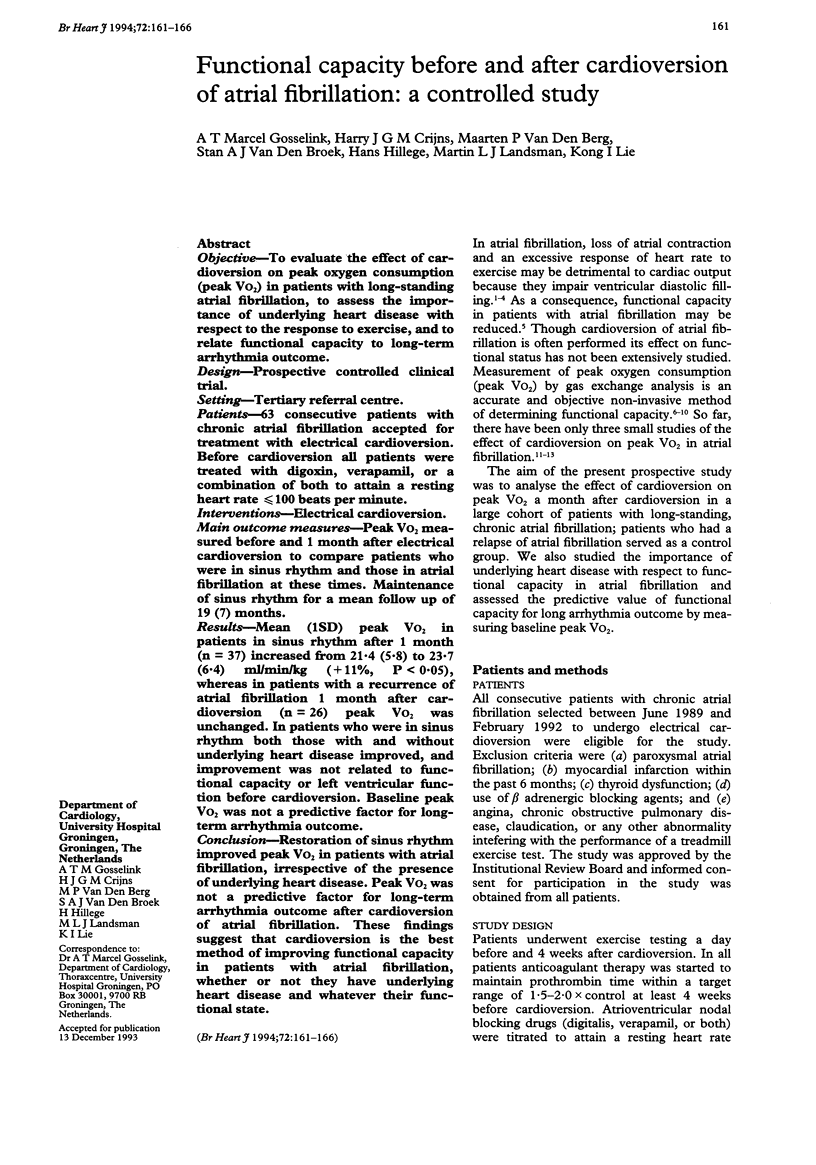
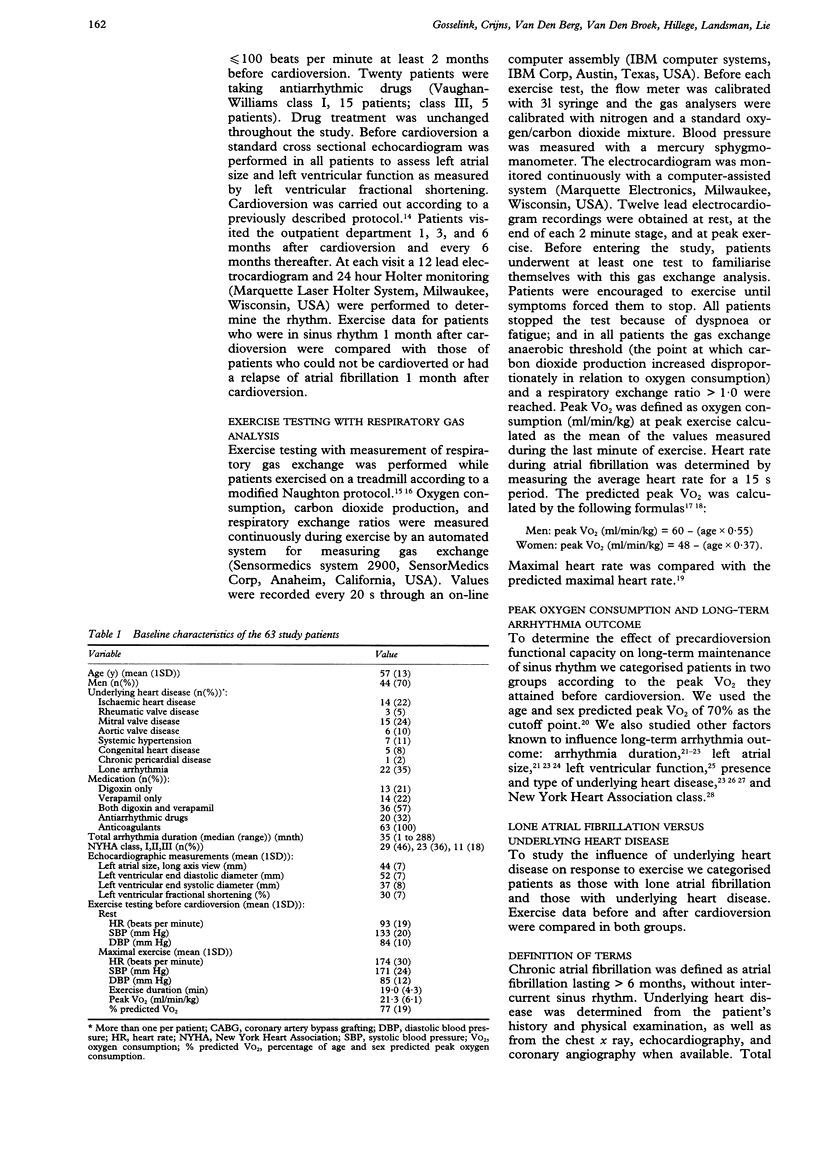
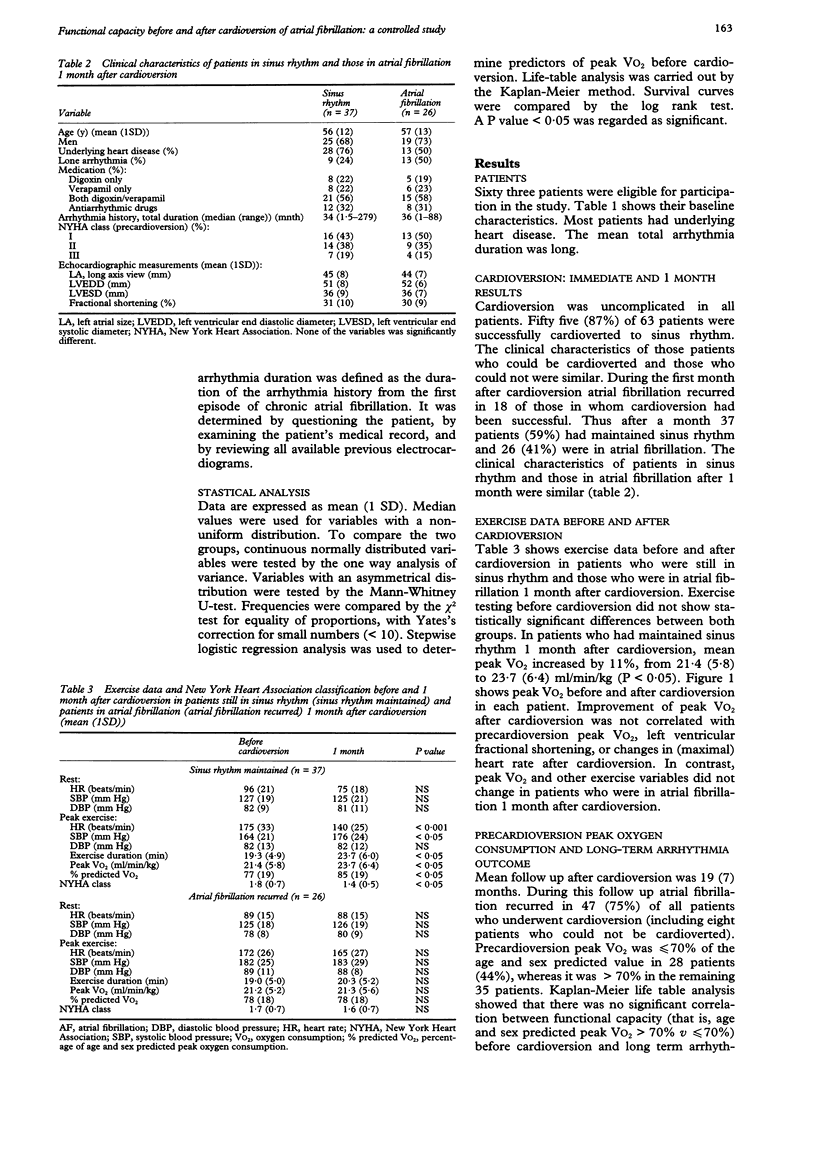
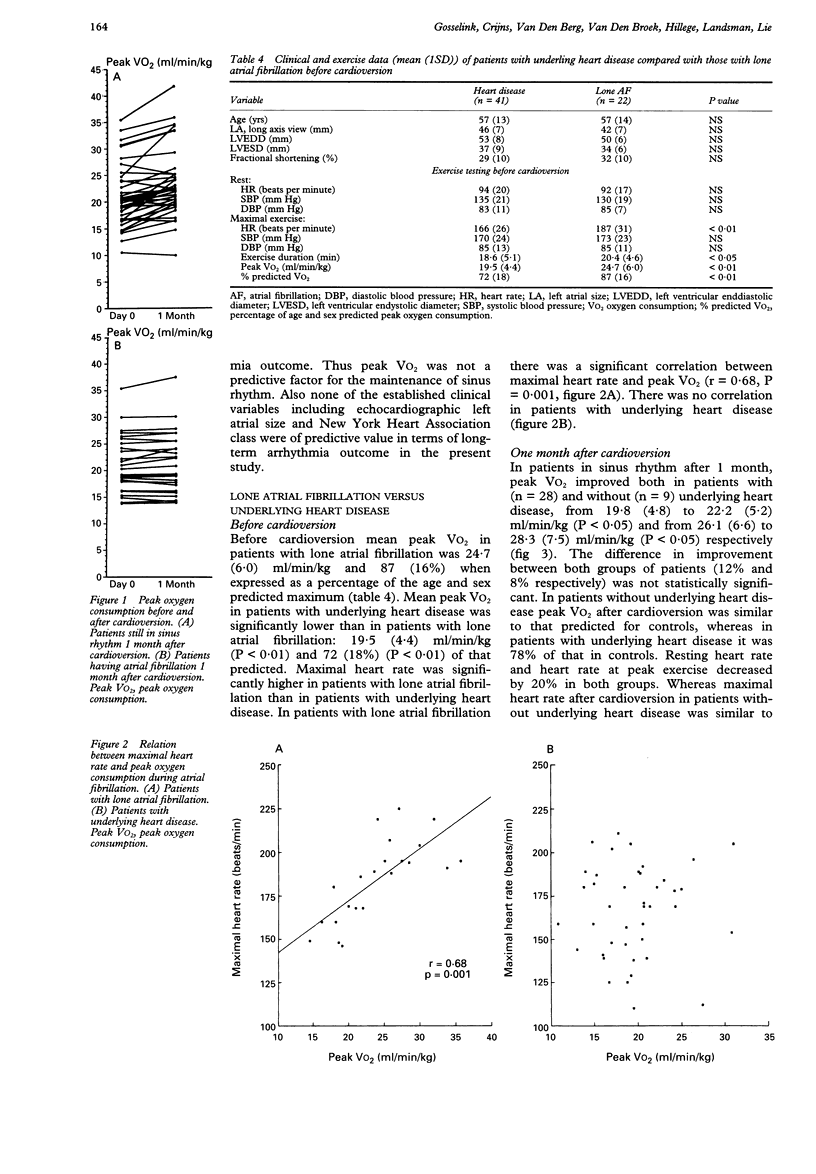
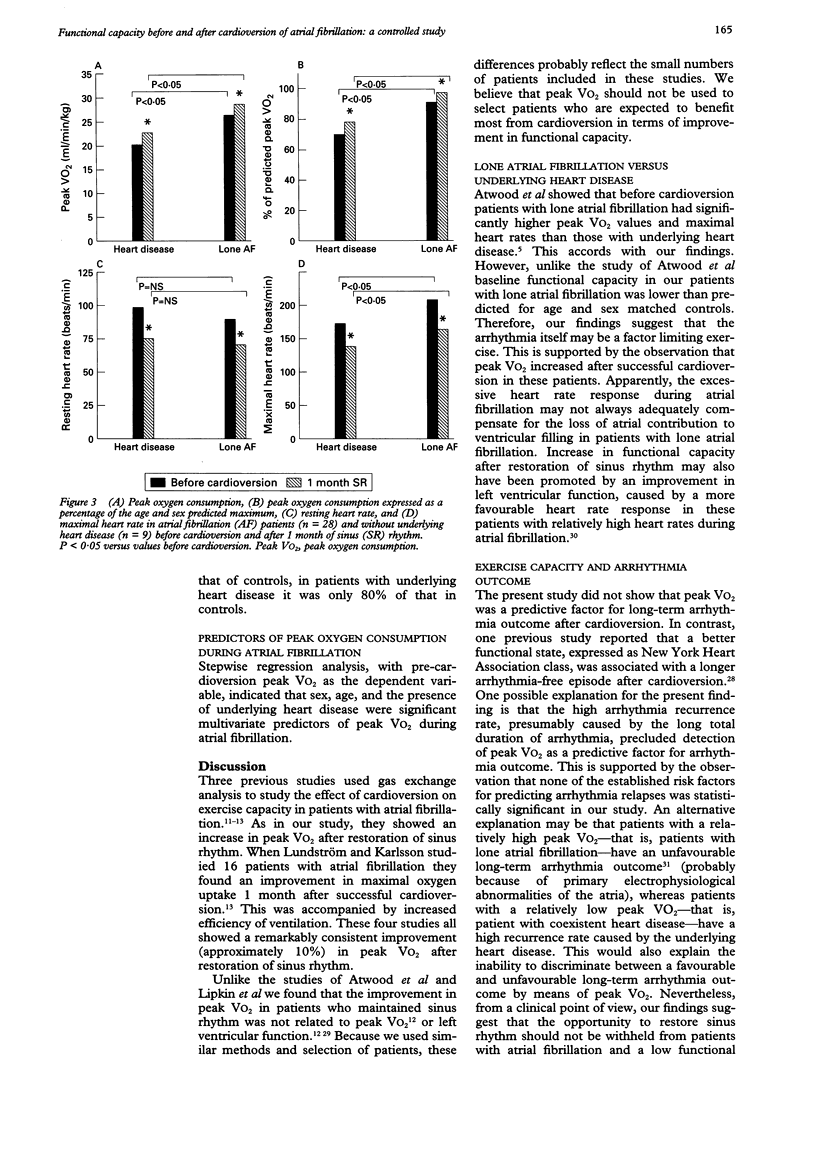
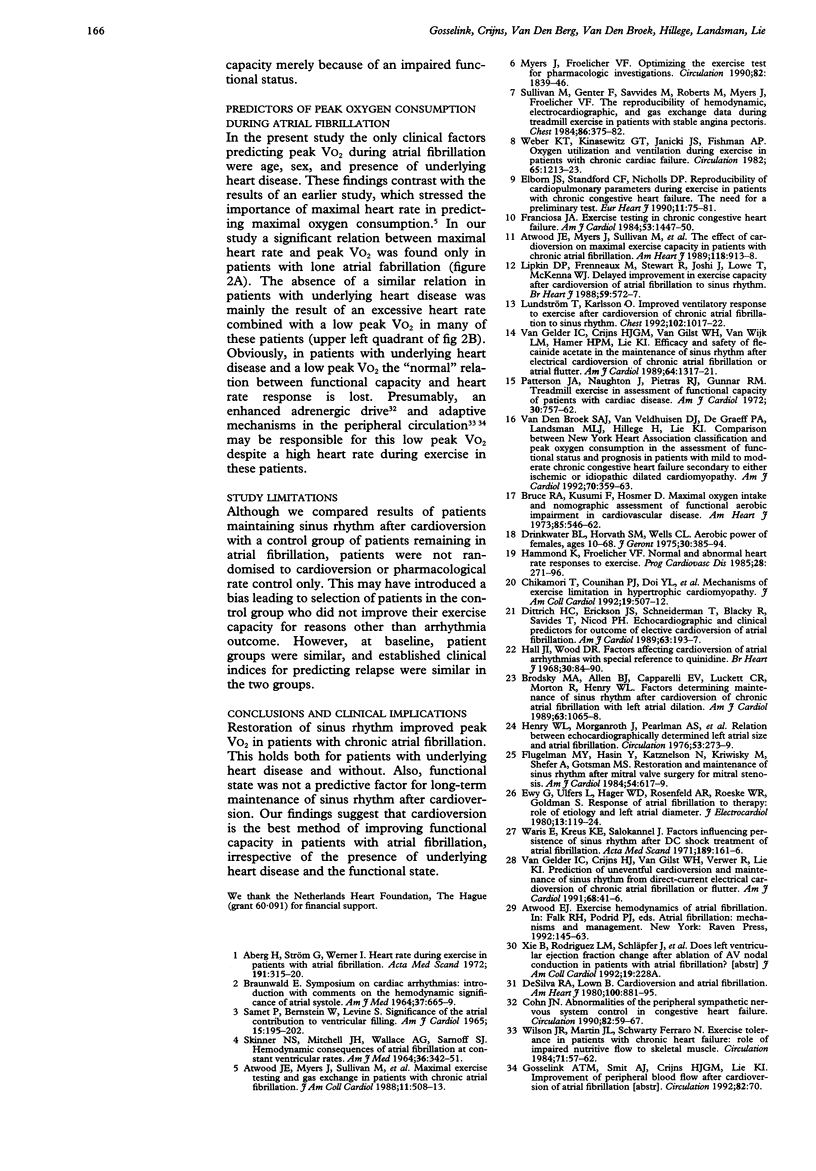
Selected References
These references are in PubMed. This may not be the complete list of references from this article.
- Aberg H., Ström G., Werner I. Heart rate during exercise in patients with atrial fibrillation. Acta Med Scand. 1972 Apr;191(4):315–320. [PubMed] [Google Scholar]
- Atwood J. E., Myers J., Sullivan M., Forbes S., Friis R., Pewen W., Callaham P., Hall P., Froelicher V. Maximal exercise testing and gas exchange in patients with chronic atrial fibrillation. J Am Coll Cardiol. 1988 Mar;11(3):508–513. doi: 10.1016/0735-1097(88)91524-0. [DOI] [PubMed] [Google Scholar]
- Atwood J. E., Myers J., Sullivan M., Forbes S., Sandhu S., Callaham P., Froelicher V. The effect of cardioversion on maximal exercise capacity in patients with chronic atrial fibrillation. Am Heart J. 1989 Nov;118(5 Pt 1):913–918. doi: 10.1016/0002-8703(89)90223-8. [DOI] [PubMed] [Google Scholar]
- BRAUNWALD E. SYMPOSIUM ON CARDIAC ARRHYTHMIAS. INTRODUCTION WITH COMMENTS ON THE HEMODYNAMIC SIGNIFICANCE OF ATRIAL SYSTOLE. Am J Med. 1964 Nov;37:665–669. doi: 10.1016/0002-9343(64)90016-6. [DOI] [PubMed] [Google Scholar]
- Brodsky M. A., Allen B. J., Capparelli E. V., Luckett C. R., Morton R., Henry W. L. Factors determining maintenance of sinus rhythm after chronic atrial fibrillation with left atrial dilatation. Am J Cardiol. 1989 May 1;63(15):1065–1068. doi: 10.1016/0002-9149(89)90079-9. [DOI] [PubMed] [Google Scholar]
- Bruce R. A., Kusumi F., Hosmer D. Maximal oxygen intake and nomographic assessment of functional aerobic impairment in cardiovascular disease. Am Heart J. 1973 Apr;85(4):546–562. doi: 10.1016/0002-8703(73)90502-4. [DOI] [PubMed] [Google Scholar]
- Chikamori T., Counihan P. J., Doi Y. L., Takata J., Stewart J. T., Frenneaux M. P., McKenna W. J. Mechanisms of exercise limitation in hypertrophic cardiomyopathy. J Am Coll Cardiol. 1992 Mar 1;19(3):507–512. doi: 10.1016/s0735-1097(10)80262-1. [DOI] [PubMed] [Google Scholar]
- DeSilva R. A., Graboys T. B., Podrid P. J., Lown B. Cardioversion and defibrillation. Am Heart J. 1980 Dec;100(6 Pt 1):881–895. doi: 10.1016/0002-8703(80)90071-x. [DOI] [PubMed] [Google Scholar]
- Dittrich H. C., Erickson J. S., Schneiderman T., Blacky A. R., Savides T., Nicod P. H. Echocardiographic and clinical predictors for outcome of elective cardioversion of atrial fibrillation. Am J Cardiol. 1989 Jan 15;63(3):193–197. doi: 10.1016/0002-9149(89)90284-1. [DOI] [PubMed] [Google Scholar]
- Drinkwater B. L., Horvath S. M., Wells C. L. Aerobic power of females, ages 10 to 68. J Gerontol. 1975 Jul;30(4):385–394. doi: 10.1093/geronj/30.4.385. [DOI] [PubMed] [Google Scholar]
- Elborn J. S., Stanford C. F., Nicholls D. P. Reproducibility of cardiopulmonary parameters during exercise in patients with chronic cardiac failure. The need for a preliminary test. Eur Heart J. 1990 Jan;11(1):75–81. doi: 10.1093/oxfordjournals.eurheartj.a059596. [DOI] [PubMed] [Google Scholar]
- Ewy G. A., Ulfers L., Hager W. D., Rosenfeld A. R., Roeske W. R., Goldman S. Response of atrial fibrillation to therapy: role of etiology and left atrial diameter. J Electrocardiol. 1980 Apr;13(2):119–123. doi: 10.1016/s0022-0736(80)80042-2. [DOI] [PubMed] [Google Scholar]
- Flugelman M. Y., Hasin Y., Katznelson N., Kriwisky M., Shefer A., Gotsman M. S. Restoration and maintenance of sinus rhythm after mitral valve surgery for mitral stenosis. Am J Cardiol. 1984 Sep 1;54(6):617–619. doi: 10.1016/0002-9149(84)90260-1. [DOI] [PubMed] [Google Scholar]
- Franciosa J. A. Exercise testing in chronic congestive heart failure. Am J Cardiol. 1984 May 15;53(10):1447–1450. doi: 10.1016/s0002-9149(84)91041-5. [DOI] [PubMed] [Google Scholar]
- Hall J. I., Wood D. R. Factors affecting cardioversion of atrial arrhythmias with special reference to quinidine. Br Heart J. 1968 Jan;30(1):84–90. doi: 10.1136/hrt.30.1.84. [DOI] [PMC free article] [PubMed] [Google Scholar]
- Hammond H. K., Froelicher V. F. Normal and abnormal heart rate responses to exercise. Prog Cardiovasc Dis. 1985 Jan-Feb;27(4):271–296. doi: 10.1016/0033-0620(85)90010-6. [DOI] [PubMed] [Google Scholar]
- Henry W. L., Morganroth J., Pearlman A. S., Clark C. E., Redwood D. R., Itscoitz S. B., Epstein S. E. Relation between echocardiographically determined left atrial size and atrial fibrillation. Circulation. 1976 Feb;53(2):273–279. doi: 10.1161/01.cir.53.2.273. [DOI] [PubMed] [Google Scholar]
- Lipkin D. P., Frenneaux M., Stewart R., Joshi J., Lowe T., McKenna W. J. Delayed improvement in exercise capacity after cardioversion of atrial fibrillation to sinus rhythm. Br Heart J. 1988 May;59(5):572–577. doi: 10.1136/hrt.59.5.572. [DOI] [PMC free article] [PubMed] [Google Scholar]
- Lundström T., Karlsson O. Improved ventilatory response to exercise after cardioversion of chronic atrial fibrillation to sinus rhythm. Chest. 1992 Oct;102(4):1017–1022. doi: 10.1378/chest.102.4.1017. [DOI] [PubMed] [Google Scholar]
- Myers J., Froelicher V. F. Optimizing the exercise test for pharmacological investigations. Circulation. 1990 Nov;82(5):1839–1846. doi: 10.1161/01.cir.82.5.1839. [DOI] [PubMed] [Google Scholar]
- Patterson J. A., Naughton J., Pietras R. J., Gunnar R. M. Treadmill exercise in assessment of the functional capacity of patients with cardiac disease. Am J Cardiol. 1972 Nov;30(7):757–762. doi: 10.1016/0002-9149(72)90151-8. [DOI] [PubMed] [Google Scholar]
- SAMET P., BERNSTEIN W., LEVINE S. SIGNIFICANCE OF THE ATRIAL CONTRIBUTION TO VENTRICULAR FILLING. Am J Cardiol. 1965 Feb;15:195–202. doi: 10.1016/0002-9149(65)90454-6. [DOI] [PubMed] [Google Scholar]
- SKINNER N. S., Jr, MITCHELL J. H., WALLACE A. G., SARNOFF S. J. HEMODYNAMIC CONSEQUENCES OF ATRIAL FIBRILLATION AT CONSTANT VENTRICULAR RATES. Am J Med. 1964 Mar;36:342–350. doi: 10.1016/0002-9343(64)90160-3. [DOI] [PubMed] [Google Scholar]
- Sullivan M., Genter F., Savvides M., Roberts M., Myers J., Froelicher V. The reproducibility of hemodynamic, electrocardiographic, and gas exchange data during treadmill exercise in patients with stable angina pectoris. Chest. 1984 Sep;86(3):375–382. doi: 10.1378/chest.86.3.375. [DOI] [PubMed] [Google Scholar]
- Van Gelder I. C., Crijns H. J., Van Gilst W. H., Van Wijk L. M., Hamer H. P., Lie K. I. Efficacy and safety of flecainide acetate in the maintenance of sinus rhythm after electrical cardioversion of chronic atrial fibrillation or atrial flutter. Am J Cardiol. 1989 Dec 1;64(19):1317–1321. doi: 10.1016/0002-9149(89)90574-2. [DOI] [PubMed] [Google Scholar]
- Van Gelder I. C., Crijns H. J., Van Gilst W. H., Verwer R., Lie K. I. Prediction of uneventful cardioversion and maintenance of sinus rhythm from direct-current electrical cardioversion of chronic atrial fibrillation and flutter. Am J Cardiol. 1991 Jul 1;68(1):41–46. doi: 10.1016/0002-9149(91)90707-r. [DOI] [PubMed] [Google Scholar]
- Weber K. T., Kinasewitz G. T., Janicki J. S., Fishman A. P. Oxygen utilization and ventilation during exercise in patients with chronic cardiac failure. Circulation. 1982 Jun;65(6):1213–1223. doi: 10.1161/01.cir.65.6.1213. [DOI] [PubMed] [Google Scholar]
- Wilson J. R., Fink L., Maris J., Ferraro N., Power-Vanwart J., Eleff S., Chance B. Evaluation of energy metabolism in skeletal muscle of patients with heart failure with gated phosphorus-31 nuclear magnetic resonance. Circulation. 1985 Jan;71(1):57–62. doi: 10.1161/01.cir.71.1.57. [DOI] [PubMed] [Google Scholar]
- van den Broek S. A., van Veldhuisen D. J., de Graeff P. A., Landsman M. L., Hillege H., Lie K. I. Comparison between New York Heart Association classification and peak oxygen consumption in the assessment of functional status and prognosis in patients with mild to moderate chronic congestive heart failure secondary to either ischemic or idiopathic dilated cardiomyopathy. Am J Cardiol. 1992 Aug 1;70(3):359–363. doi: 10.1016/0002-9149(92)90619-a. [DOI] [PubMed] [Google Scholar]


